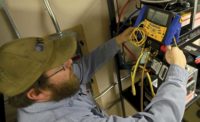The increase of onboard diagnostic technology has overflowed into the diagnostic tool market. New demand is pushing for enhanced tool capabilities and functions. Both the HVACR installer and service technician are experiencing a need for these enhanced tools, and manufacturers are working to provide just that.
SOPHISTICATED DIAGNOSTIC TOOLS
According to Gary Lampasona, vice president of sales and marketing for Ritchie Engineering Co. Inc., there are three current trends ranking top of mind for many in the diagnostic tool industry. The first is the way that diagnostic tools communicate. Lampasona has seen an increase in demand for diagnostic tools to communicate with smartphones across multiple platforms. Although these tools have communicated through different avenues in the past, there is a push for them to upgrade to the next generation of technology, including via Bluetooth, Wi-Fi, and newly designed ports.
Another trend looks at the ability of the diagnostic tool to provide potential recommended actions. As onboard diagnostics are shifting from error indicators to more advanced intelligent system monitors, the HVACR equipment is getting smarter and sometimes offers solutions to the problems that are discovered. According to Lampasona, this growing trend demands that diagnostic tools move from data indicators to enhanced problem-solvers by providing an analysis of the data collected.
A third trend he noticed takes a look not at troubleshooting, but at the setup side of HVACR equipment.
Understanding that high-efficiency systems are less effective when not installed and verified properly, some manufacturers are tying in setup and performance verification into their warranty statements, especially in regard to boilers and furnaces, according to Jason Esteves, HVAC and IAQ product manager, E Instruments/Sauermann Group.
“No manufacturer wants their equipment set up by eye anymore — not with the proper equipment available on the market these days that will do the job correctly,” said Esteves. “This is a major reason why manufacturers are actually putting combustion parameters in the manuals for proper setup. They have it in writing for liability reasons, and some have gone further and required a combustion analysis in order to carry the warranty on the equipment.”
CHANGE IS GOOD
As the future of advanced HVACR technology and diagnostic tools unfolds, there will be changes that likely come frequently and at a quicker pace.
“New technology is a good thing, and being able to provide better and more useful equipment and solutions to the market will be a requirement as instrumentation technology changes,” Esteves said. “This frequent and continuous innovation will likely yield more frequently released tools and instruments.”
What Esteves did warn technicians about as the HVACR technology landscape evolves is their attitudes. He explained that those not willing to educate themselves and expand their skills will find that the sophistication of some of the new equipment could prove to be a problem for them in the field.
“Just because this is how you’ve been working for 20 or 30 years doesn’t mean that it is correct at all, or that there isn’t a better, more advanced, safer, and more efficient way of doing the job,” he said.
Lampasona agreed that HVAC equipment and the diagnostic tools required to install and repair it are only going to increase in technological complexity. He sees these advancements coming to a head in the next decade.
“There will be complete integration with the IoT,” he said. “This will provide for complete diagnostics and solutions for service companies and consumers.”
A FEW OF OUR FAVORITE TOOLS
Technicians across the nation are in the field testing and using these new diagnostic tools as they reach the market. The technicians at Professional HVAC/R Services Inc., Avon Lake, Ohio, have found some of their favorite diagnostic tools to be a micron gauge and an advanced leak detector. According to them, leaving moisture or leaks in any system means trouble in the future. They each use the same methods any time a refrigeration system is engaged and follow procedures proven to give the best results.
Over in Dunedin, Florida, some technicians from Dunedin Refrigeration keep their favorite tools on hand, like a digital manifold gauge and an infrared camera. According to them, the manifold gauge provides all the information necessary on the refrigerant side from the superheat and subcooling to the static pressure and even the capacity of the system. As for the infrared camera, it lets technicians know if there are issues with the duct system or leaks in the supply and return air sides.
Mike Hendrix, owner of HendrixAir, Nahunta, Georgia, identified a static pressure gauge as his favorite tool.
“I love it that no one else seems to use it to truly diagnose airflow,” he said.
For Esteves, his favorite tool is a combustion analyzer, although he admits that he is a little biased toward that tool, seeing as where he works.
“A combustion analyzer, however, is not just a specialized tool used a couple times a year, which is a very common misconception,” he said. “In this day and age, it is a must-have, everyday diagnostic tool for any HVAC professional. It’s an imperative and important tool to make sure the equipment we touch, service, and install every single day is running efficiently and safely.”
Along with their favorites, every technician should have certain tools in their toolbox.
“When it comes to what every technician should have in their toolbox, it is important to choose diagnostic tools that provide complete solutions,” said Lampasona. “Then add digital manifolds and test instruments designed as a platform for integration for additional sensors and tools.”
Publication date: 1/28/2019
Want more HVAC industry news and information? Join The NEWS on Facebook, Twitter, and LinkedIn today!








